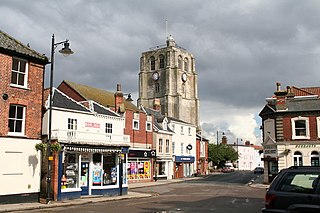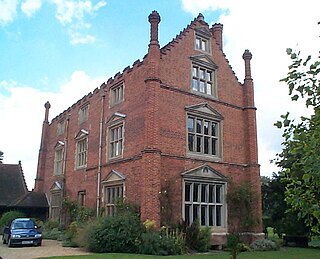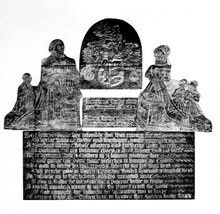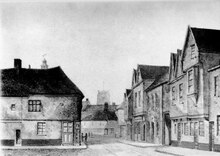
Beccles is a market town and civil parish in the English county of Suffolk. The town is shown on the milestone as 109 miles (175 km) from London via the A145 and A12 roads, 98 miles (158 km) north-east of London as the crow flies, 16 miles (26 km) south-east of Norwich and 33 miles (53 km) north-northeast of the county town of Ipswich. Nearby towns include Lowestoft to the east and Great Yarmouth to the north-east. The town lies on the River Waveney on the edge of The Broads National Park.

Sir John Suckling was an English politician who sat in the House of Commons at various times between 1601 and 1627.

Thomas Seckford or Thomas Sakford Esquire was a senior lawyer, a "man of business" at the court of Queen Elizabeth I, a landowner of the armigerous Suffolk gentry, Member of Parliament, and public benefactor of the town of Woodbridge. He was one of the Masters in Ordinary of the Court of Requests to Queen Elizabeth, 1569-1587, and was Surveyor of the Court of Wards and Liveries 1581-1587. He built mansions in Woodbridge, Ipswich and Clerkenwell, and was at different times Steward of the Liberty of Ely in Suffolk, Bailiff for the Crown of the former possessions of Clerkenwell Priory in the City of London and County of Middlesex, and deputy Steward for the northern parts of the Duchy of Lancaster. He was the patron of Christopher Saxton in the making of the first surveyed County Atlas of England and Wales.
Andrew Windsor, 1st Baron WindsorKB (1467–1543), was a Member of Parliament, English peer, and Keeper of the Wardrobe, knight banneret and military commander.

Sir Clement Higham, or Heigham, of Barrow, Suffolk, was an English lawyer and politician, a Speaker of the House of Commons in 1554, and Chief Baron of the Exchequer in 1558–1559. A loyal Roman Catholic, he held various offices and commissions under Queen Mary, and was knighted in 1555 by King Philip, but withdrew from politics after the succession of Queen Elizabeth I in 1558.

Sisland, historically Sislanda, is a very small village, manor and parish in the county of Norfolk, England, about a mile west of Loddon. In the 2001 census, the population was 44 in 16 households. The parish covers an area of 1.90 km2 (0.73 sq mi), and is approximately 9.3 miles (15.0 km) southeast of Norwich and 12.7 miles (20.4 km) west of Great Yarmouth. For the purposes of local government, it falls within the district of South Norfolk, however Sisland does have its own Parish Council. The village contains only one heritage-listed building, that being St Mary's Church, which is Grade II*.
The Blois family have been substantial landowners in Suffolk for several centuries. Until recently the family home was at Cockfield Hall in Yoxford, Suffolk, a Grade 1 listed private house standing in 40 acres (160,000 m2) of historic parkland.

Rede is a village and civil parish in the West Suffolk district of Suffolk in eastern England. Its location is situated South East of Chedburgh. In 1887 Rede was described as being "7 miles S[outh] W[est] of Bury St Edmonds, 1224 ac[res], pop[ulation] 224".
The East Anglian League was a football league in the East Anglia region of England.

John Clench was an English judge, a Serjeant-at-Law, Baron of the Exchequer and Justice of the Queen's Bench, of the late Tudor period. He established his family in south-east Suffolk, in the neighbourhood of Ipswich, where for many years he was the Town Recorder.
Robert Daundy, of Ipswich, Suffolk, was an English businessman and politician. He was closely associated with another Ipswich businessman, Henry Tooley.
Edmund Daundy, of Ipswich, Suffolk, was an English politician and Ipswich merchant. He was a Member of Parliament (MP) for Ipswich in 1512 and 1515
William Sabine, also Sabyn or Sabyan, of Ipswich, Suffolk, was an English merchant, ship-owner, naval sea-captain and municipal figure. He was a Member of Parliament (MP) for Ipswich in 1539, with Edmund Daundy.
Sir John Sulyard, of Wetherden and Haughley, Suffolk, was a prominent East Anglian magistrate, landowner, High Sheriff, knight and standard-bearer, strongly Roman Catholic in religious affiliation, who sat in parliament during the reign of Queen Mary.

Edmund Withypoll, Esquire, of London, of Walthamstow, Essex, and of Ipswich, Suffolk, was an English merchant, money-lender, landowner, sheriff and politician, who established his family in his mother's native county of Suffolk, and built Christchurch Mansion, a distinguished surviving Tudor house, as his Ipswich home.
William Smarte, of Ipswich, Suffolk, was an English politician.

Ipswich Blackfriars was a medieval religious house of Friars-preachers (Dominicans) in the town of Ipswich, Suffolk, England, founded in 1263 by King Henry III and dissolved in 1538. It was the second of the three friaries established in the town, the first being the Greyfriars, a house of Franciscan Friars Minors, and the third the Ipswich Whitefriars of c. 1278–79. The Blackfriars were under the Visitation of Cambridge.

Henry Davy (1793–1865) was an English landscape painter, engraver and lithographer active in East Anglia.

Sir Edward Echyngham, , of Barsham and Ipswich in Suffolk, was a commander on land and at sea, briefly Constable of Limerick Castle, and Collector of Customs at Ipswich. He is remembered as the author of a letter to Cardinal Wolsey describing the death of Lord Admiral Howard at Brest in 1513. From 1485 the presence of the Howard Dukes of Norfolk was felt directly along the Barsham reach of the River Waveney from their possession of Bungay Castle.

John Speed's Ipswich is a graphic account of the town of Ipswich, Suffolk created by John Speed in conjunction with the Dutch engraver, Jodocus Hondius, in 1610. It was featured as an inset for his map of the county of Suffolk, published in Theatre of The Empire of Great Britaine. It is the earliest extant map of Ipswich and features many buildings of the late medieval period, whilst at the same time showing streets laid out in a grid pattern which has largely been retained into the twenty first century.













